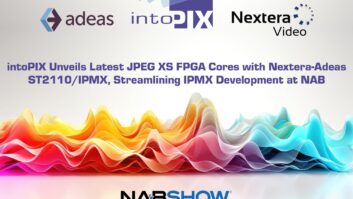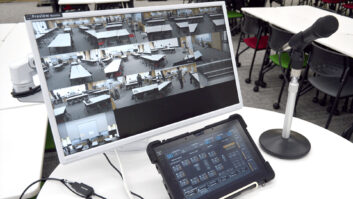Dazzling Reflections
Mar 1, 2003 12:00 PM,
Mark Mayfield
Texas Instruments (TI) is the developer of Digital Light Processing (DLP) technology, the enabling technology that has really triggered the light-speed advancement of the high-brightness projection industry. DLP technology is based on the invention of a micromechanical device called the Digital Micromirror Device (DMD), which was called “the weirdest technology ever invented” by PC magazine. More than 1.5 million products have been shipped from more than 50 manufacturers using the TI-licensed technology. The DMD is a proprietary optical semiconductor that manipulates light digitally, resulting in brightness levels exceeding 17,000 ANSI lumens — bright enough for the largest venues. But its reach is not limited to the very high-end; products based on a single-chip DLP technology extend down to the home market while the high-end three-chip products cover applications in which extreme high output is required. In the case of single-chip systems, white light generated by the lamp is passed through a color wheel as it travels to the surface of the DMD panel. The color wheel filters the light into red, green, and blue, from which a single-chip DLP projection system can create at least 16.7 million colors. The three-chip architecture splits the light from the lamp using a prism: red light is directed to the surface of one DMD, blue to the second, and green to the third. The output from the three DMDs is optically recombined to create the image. DLP Cinema technology is capable of producing no fewer than 35 trillion colors.
At the recent CES show in Las Vegas, I talked with Wayne Reynolds — business development manager, commercial entertainment products, at TI — about current and future developments in this exciting “enabling technology” as it relates to the commercial installation market.
Q: What are the applications for single-chip DLP technology versus three-chip?
There is a portfolio of products that the DLP technology is enabling. The single-chip products are finding wide acceptance primarily in the smaller portable business products, as well as the home space. In the home, of course it’s much more of a consumer target where we’re talking mainly about rear-projection TV. With front projection, generally it’s a different customer base. Most of these are business products for the commercial market, where features like portability and small size are important. All of these are at the lower end of the lumens scale.
Q: What is the dividing line for single-chip output versus three-chip output?
There is an always-changing line — it’s not a static division point. But in general, single-chip products are up in the 2,500-to-3,000-lumens range today, and the three-chip product begins at the low end, around 5,000 lumens, up to about 17,000 lumens.
Q: Who are some of the partner companies in three-chip?
We’ve had a long relationship with a number of high-end partners like Barco, Digital Projection, Christie Digital, NEC, MEI [branded as Panasonic], and others. These have been the “core” three-chip partners for the past several years. We’re now in the midst of some growth opportunities with three-chip DLP technology that has allowed us to broaden that customer base a little.
Q: What are the growth areas for three-chip DLP technology?
Well, of course there’s DLP Cinema technology; everyone recognizes the opportunity to replace the installed base of film projectors around the world. That’s one key growth area for the team I’m on, which is Commercial Entertainment, three-chip products. On the pro venue side, the growth areas are really down market from our current position, where we have three-chip DLP product today. We plan to stay very true to the image quality reputation that we’ve garnered over the past several years — and take that same performance and bring it down to a new size and weight point but, most importantly, to a new price point to expand the market for three-chip DLP products. Currently, the three-chip systems represent a small percentage of the 1.5 million user base that we talk about. This is primarily because most DLP three-chip systems are fairly high-end, with an entry point of roughly $40,000 to upwards of $120,000. A couple years from now, if we’re successful in moving down market, we may see entry points for our next generation three-chip DLP technology at around $15,000, so we’re talking about a pretty profound shift.
Q: What kinds of products can we expect to see from TI in terms of future generations of DLP technology?
There is, of course, always a pipeline of products coming, most of which are too early to talk about, but I can tell you that what we’re working toward is bringing the performance that we’re known for delivering in the professional environment down to new levels of small size and low weight. To do that is actually more about driving the supply base in an aggressive way to get the cost structure in line with those price points.
As we try to aim down market, we have to look at the entire bill of materials to bring costs down. You’re seeing the evidence of the first of the new generation three-chip DLP technology-based products right here on the CES show floor with Panasonic. Its new PT-D7600U provides 6,000 ANSI lumens output with 1,280-by-1,024 SXGA native resolution for under $30,000, and it weighs just a little over 40 pounds (without the lens). I think it’s very indicative of what can be achieved, and I think it’s a leading edge indicator of where we’re going.
Q: In the 5,000-lumens-and-up projection category, is DLP technology the dominant technology?
Well, going back a few years ago, it was really the only technology that could practically produce these kinds of light levels. Of course, all of that is changing with polysilicon coming up as an emerging technology. And there are some attempts from LCoS to position itself as with high-brightness products, but I view them as a distant second to polysilicon. But as a general comment, I would say pay attention to three-chip DLP technology. As we come down market, it’s going to be easier and easier to justify specifying these high-end systems. I think we’re going to see a significant wave of products coming out at really unheard-of price points with the kind of performance we’ve become known for, with maybe less attention on “ruggedness” and more attention to systems that deliver the same quality level on screen but are designed to be installed and left alone in a certain environment. So when you combine the performance with a more affordable price and a certain set of features more targeted at typical fixed installation users, I think the advantages of DLP systems among the systems integration and high-end home-theater markets will become apparent. On top of that, I think a trait where you’ll see DLP technology really excel is reliability, which we define as the ability to maintain image quality over the life of the product.
Q: What do you consider to be competing technologies to the high output three-chip DLP technology?
The strongest competition is high-brightness polysilicon, primarily 1.8-inch polysilicon-based LCD projectors. Increasingly, 1.3-inch, 1.39-inch LCD is the panel technology that we’re keeping our eye on, which will come up in brightness, as well.
Q: Do you think three-chip DLP technology will eventually replace all single-chip applications?
There is an image-quality advantage with three-chip, and that advantage may be due to the fact that we have inherently higher bandwidth — we don’t have to share a time sequence for the delivery of all three colors; we dedicate one DMD for every primary color, so of course, that does generate a performance advantage. But I think we also have to recognize that a three-chip system is inherently more complex, so there’s more cost. So for the average user, and given the trade-off with price points, leads me to say, no, I don’t see the three-chip supplanting one-chip in the long term; I see them coexisting. In fact, one-chip DLP technology has seen significant improvements recently as a result of the development of TI’s Sequential Color Recapture [SCR] process [see Fig. 1]. SCR is an innovation in scrolling color that produces a 40 percent boost in lumen output compared to traditional field sequential color systems. Instead of splitting a light source into three primary colors and manipulating each color on a separate chip, SCR achieves the same result with no moving components other than a color wheel, achieving nearly the efficiency of three-chip systems with a single chip.










